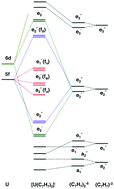Modeling the electronic states and magnetic properties derived from the f1 configuration in lanthanocene and actinocene compounds†
Abstract
The electronic structure and magnetic properties of a series of Kramers ions with f1 configuration in axial symmetry have been analyzed with a combination of theoretical methods: ab initio relativistic wavefunction methods as well as a crystal-field (CF) model with parameters extracted from the ab initio calculations. The molecules were treated in an idealized D8h and D7h symmetry and different combinations of active electrons and orbitals were used to describe correctly the nature of the ground and excited states. The spin Hamiltonian parameters for the Kramers doublet derived from the ground multiplet were determined and discussed on the basis of the crystal-field (CF) and spin–orbit interaction. The prime interests were the electron paramagnetic resonance g-factors and their relation to the complex geometry, crystal-field (CF) and spin–orbit coupling. The developed models agree well with the ab initio calculations and experimental reports.



 Please wait while we load your content...
Please wait while we load your content...